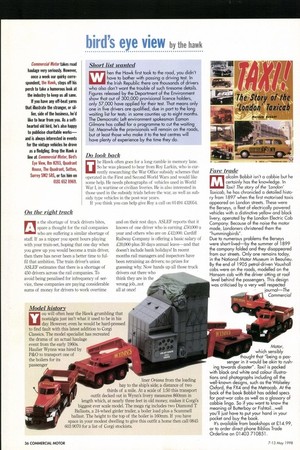bird's eye view by the hawk Short list wanted hen
Page 36

If you've noticed an error in this article please click here to report it so we can fix it.
the Hawk first took to the road, you didn't have to bother with passing a driving test. In the Irish Republic there are thousands of drivers who also don't want the trouble of such tiresome details. Figures released by the Department of the Environment show that out of 300,000 provisional licence holders, only 57,000 have applied for their test. That means only one in five drivers are qualified, due in part to the long waiting list for tests: in some counties up to eight months. The Democratic Left environment spokesman Eamon Gilmore has called for a programme to cut the waiting list. Meanwhile the provisionals will remain on the roads, but at least those who make it to the test centres will have plenty of experience by the time they do.
Do look back he Hawk often goes for a long ramble in memory lane. So he was pleased to hear from Roy Larkin, who is currently researching the War Office subsidy schemes that operated in the First and Second World Wars and would like some help. He needs photographs of vehicles used in World War I, in wartime or civilian liveries. He is also interested in those used in the subsidy trials before the war, as well as subsidy type vehicles in the post-war years.
If you think you can help give Roy a call on 01494 432054.
On the right track A s the shortage of truck drivers bites, spare a thought for the rail companies who are suffering a similar shortage of staff. If as a nipper you spent hours playing with your train-set, hoping that one day when you grew up you would become a train driver, then there has never been a better time to fulfil that ambition. The train driver's union ASLEF estimates that there is a shortage of 450 drivers across the rail companies. To avoid being penalised for infrequency of service, these companies are paying considerable sums of money for drivers to work overtime and on their rest days. ASLEF reports that it knows of one driver who is earning £50,000 a year and others who are on £42,000. Cardiff Railway Company is offering a basic salary of £20,000 plus 30 days annual leave—and that doesn't include bank holidays! In recent months rail managers and inspectors have been retraining as drivers; no prizes for guessing why. Now hands up all those truck drivers out there who think they are in the wrong job...not all at once! Fare trade tA alcolm Bobbit isn't a cabbie but he certainly has the knowledge. In Taxi! The story of the 'London' Taxicab, he has chronicled a detailed history from 1897 when the first motorised taxis appeared on London streets. These were the Berseys, a fleet of electrically powered vehicles with a distinctive yellow and black livery, operated by the London Electric Cab Company. Because of the noise the motor made, Londoners christened them the "hummingbirds". Due to numerous problems the Berseys were short-lived—by the summer of 1899 the company folded and they disappeared from our streets. Only one remains today, in the National Motor Museum in Beaulieu. By the end of 1905 petrol-driven Vauxhall cabs were on the roads, modelled on the Hansom cab with the driver sitting at roof level behind the passengers. This design was criticised by a very well respected journal—The Commercial Motor, which sensibly thought that "being a passenger in it would be akin to rushing towards disaster". Taxi! is packed with black and white and colour illustrations and photographs including all the well-known designs, such as the Wolseley Oxford, the FX4 and the Metrocab. At the back of the book Bobbit has added specs for post-war cabs as well as a glossary of cabbie lingo. So if you want to know the meaning of Butterboy or Fishtail.. well you'll just have to put your hand in your pocket and buy the book. It's available from bookshops at 214.99, or to order direct phone Biblios Trade Orderline on 01403 710851. Model history Elou will often hear the Hawk grumbling that nostalgia just isn't what it used to be in his day. However, even he would be hard-pressed to find fault with this latest addition to Corgi Classics. The model specialist has recreated the drama of an actual haulage event from the early 1960s. Haulier Wynns was hired by P&O to transport one of the boilers for its passenger • liner Oriana from the loading bay to the ship's side; a distance of two thirds of a mile. At a scale of 1:50 this transport outfit decked out in Wynn's livery measures 860mm in length which, at nearly three feet in old money, makes it Corgi's biggest ever scale model. The mega rig includes two Diamond T Ballasts, a 24-wheel girder trailer, a boiler load plus a Scammell ballast. The height to the top of the boiler is 160mm. If you have space in your modest dwelling to give this outfit a home then call 0845 603 9070 for a list of Corgi stockists.
























































































































